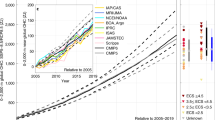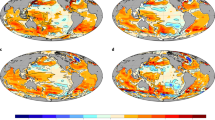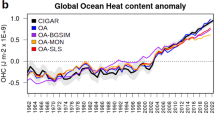Abstract
FOR the Intergovernmental Panel on Climate Change (IPCC) report1, using a simple climate/ocean model, we made projections of the greenhouse warming to 2100. Projections were made for four greenhouse-gas scenarios, whose radiative effects in 2100, expressed in terms of an equivalent amount of CO2, ranged from 2 to 5.5 times the pre-industrial CO2 concentration. The projected global warming in 2100 for these scenarios, relative to 1990, ranged from 0.62–2.31 °C for the minimum assumed CO2-doubling temperature sensitivity, ΔT2x = 1.5 °C, to 1.61–5.15 °C for the maximum sensitivity ΔT2x = 4.5 °C. Here we broaden these projections to include a recently suggested lower sensitivity, ΔT2x = 0.5 °C. We also revise all projections by prescribing, using the results of our analysis of simulations by a coupled atmosphere-ocean general circulation model, a lower value for a key parameter of the simple ocean model, II, which indicates the warming of the polar ocean relative to the warming of the non-polar ocean. We find that, for any value of ΔT2x, the atmospheric temperature increases more rapidly with time as a consequence of the reduction in II. We also find that a delay of ten years in initiating a 20-year transition from the IPCC 'business-as-usuaP scenario to any other IPCC scenario has only a small effect on the projected warming in 2100, regardless of the value of ΔT2x. This indicates that the penalty for a 10-year delay is small.
This is a preview of subscription content, access via your institution
Access options
Subscribe to this journal
Receive 51 print issues and online access
$199.00 per year
only $3.90 per issue
Buy this article
- Purchase on Springer Link
- Instant access to full article PDF
Prices may be subject to local taxes which are calculated during checkout
Similar content being viewed by others
References
1. Houghton, J.T., Jenkins, G.J.& Ephraums, J.J. (eds) Climate Change: The IPCC Scientific Assessment (Cambridge University Press, 1990). 2. Hoffert, M. I., Callegari, A. J. & Hsieh, C.-T. J. geophys. Res. 85, 6667-6679 (1980). 3. Hoffert, M. I. & Flannery, B. P. in Projecting the Climatic Effects of Increasing Carbon Dioxide (eds MacCracken, M. C. & Luther, F. M.), 149-190 (US Department of Energy, Washington, DC 1985). 4. Schlesinger, M. E. & Jiang, X. J. dim. 3, 1297-1315 (1990). 5. Schlesinger, M. E. & Mitchell, J. F. B. Rev. Geophys. 25, 760-798 (1987). 6. Lindzen, R. S. Bull. Am. meteorol. Soc. 71, 288-299 (1990). 7. Wigley, T. M. L. & Raper, S. C. B. in Greenhouse-gas-induced Climatic Change: A Critical Appraisal of Simulations and Observations (ed. Schlesinger, M. E.) 471-482 (Elsevier, Amsterdam, 1991). 8. Charlson, R. J., Langner, J & Rodhe, H. Nature 348, 22 (1990).
Author information
Authors and Affiliations
Rights and permissions
About this article
Cite this article
Schiesinger, M., Jiang, X. Revised projection of future greenhouse warming. Nature 350, 219–221 (1991). https://doi.org/10.1038/350219a0
Received:
Accepted:
Issue Date:
DOI: https://doi.org/10.1038/350219a0
This article is cited by
-
Emulating AOGCM results using simple climate models
Climate Dynamics (2010)
-
Climate-vegetation interannual variability in a coupled atmosphere-ocean-land model
Advances in Atmospheric Sciences (2009)
-
A welfare-based index for assessing environmental effects of greenhouse-gas emissions
Nature (1996)
-
Development of a risk-hedging CO2-emission policy, part II: Risks associated with measures to limit emissions, synthesis, and conclusions
Climatic Change (1996)
-
The risk of sea level rise
Climatic Change (1996)
Comments
By submitting a comment you agree to abide by our Terms and Community Guidelines. If you find something abusive or that does not comply with our terms or guidelines please flag it as inappropriate.



